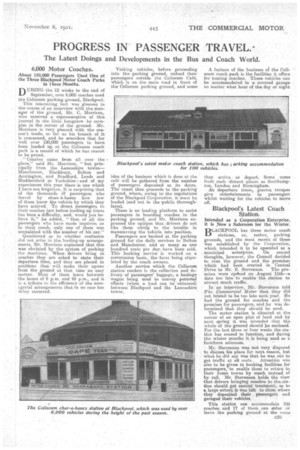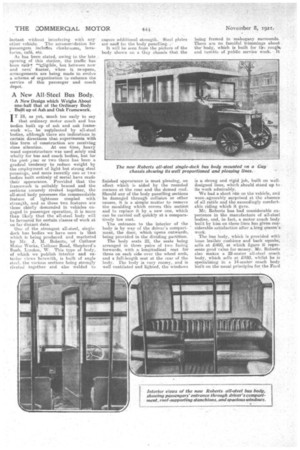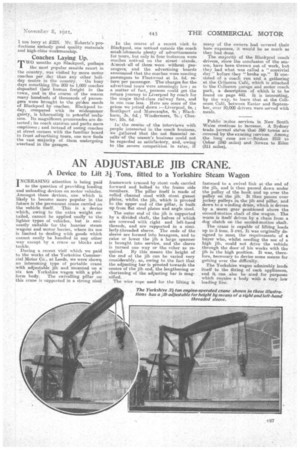PROGRESS IN PASSENGER TRAVEL.
Page 21

Page 22

Page 23

If you've noticed an error in this article please click here to report it so we can fix it.
The Latest Doings and Developments in the Bus and Coach World.
6,000 Motor Coaches.
About 150,000 Passengers Used One of the Three Blackpool Motor Coach Parks in '.I. hree Months. DIMING the 12 weeks to the end of September, over 6,000 coaches used the Coliseum parking ground, Blackpool.
This interesting fact was gleaneu in the course of an interview with the manager of the ground, Mr. C. Morrison, who received a representative of this journal in the little bungalow he occupies in the corner of the 'ground, Mr_ Morrison is very pleased with the season's trade, so far as his branch of it is concerned, and he considers that for well over 150,000. passengers to have been leaded up at the Coliseum coach park is a record of which he has reason to be proud.
"Coaches came from all over the place," said Mr. Morrison, " but principally from the Lancashire towns— Manchester, Blackburn, Bolton and Accrington, and Bradford, Leeds and Huddersfield in Yorkshire—and of my experiences this year there is one which I have not forgotteo, it is surprising that of the thousands dl passengers who travel by chars-a-barics how few of them know the vehicle by which they have arrived. To direct passengers to their coaches just before loading-up times has been a difficulty, and, would you believe it," he added, " that of all the passengers who have made inquiries as to their coach, only one of them was acquainted with the number of his car."
Questioned as to whether confusion did not arise in tho loading-up arrangements, Mr. Morrison explained that this was obviated by the system of parking the machines. When drivers bring in coaches they are asked to state their departure time, and they are placed in positions that wilt make their egress from the ground at that time an easy matter. Most, of them leave between the hours of 6 p.m. and 10 p.m., and it is a tribute to the efficiency of the managerial arrangements that in DO case has delay occurred.
Visiting vehicles, before proceeding into the parking ground, unload their passengers outside the Coliseum Cafe, Which is on the main road in front. of the Coliseum parking ground, and some idea of the business which is done at. the café will be gathered from the number of passengers deposited at its doors. The coach then proceeds to the parking ground, where, owing to the regulations of the Blackpool Corporation, it mast be loaded (and not in the-public thoroughfares).
There is no loading platform to assist passengers in boarding coaches in the parking ground, and Mr. Morrison ex. pressed the opinion that drivers do not like them owirig to the trouble in manceuvring the vehicle into position.
Passengers are booked at the parking ground for the daily services to Bolton and Manchester, and as many as one hundred seats per dayhave been sold. This booking service is worked on a commission basis, the fares being stipulated by the coach owners.
Another service which the Coliseum station renders is the collection and delivery of passengers' luggage, a haulage wagon being used to convey personal effects (when a load can be obtained) between Blackpool and the Lancashire towns, A feature of the business of the Coliseum coach park is the facilities it offers for touring coaches. These vehicles can be accommodated in a covered garage no matter what hour of the day or night they arrive or depart. Some come from such distant places as Southampton, London and Birmingham.
At departure times,, pies-rot troupes give entertainments to passengers whilst waiting for the vehicles to move off.
Blackpool's Latest Coach Sotion.
Intended as a Corporation Enterprise, it is Now a Saleroom for the Winter.
BLACKPOOL has three motor coach stations, or, rather, parking grounds, and the most recent of these was established by the Corporation, which intended it to be operated as a municipal enterprise. On second thoughts, however, the Council decided to rent the gronnd and the premises which had been erected in Central Drive to Mr. B. Stevenson. The premises were opened on August 11th—a date too late to enable • the station to attract much traffic.
In an interview, Mr. Stevenson told .TIac Commercial Motor that they did not intend to be too late next year. He had the ground for coaches and the premises for passengers, and he was determined that they should be used.
The motor station is situated at the corner of an open plot of land and by next spring it was intended that the whole of the ground should be enclosed. For the last three or four weeks the station has ceased to function, and during the winter months it is being used as a furniture saleroom.
Mr. Stevenson was not very disposed to discuss his plans for next season, but what be did say was that he was out to get traffic at all costs. Attention was also to be given to booking facilities for pa.ssengers,"to enable them to return to their home towns by teach instead of by rail. Mr. Stevenson holds the view that drivers bringing coaches to the, station should get special treatment, as to u large extent it was left to them where they deposited their passengers and garaged their vehicles.
This station can accommodate WO coaches and 17 of them can enter or leave the parking ground at the same 025
instant without interfering with any other vehicle. The accommodation for passengers inclutles cloakrooms, lavatories, cafe, etc.
As has been stated, owing to the late opening of this station, the traffic has been rattri --eligible, but between now and next Easter, when it re-opens, arrangements are being made to evolve a scheme of organization to-enhance the service of this passenger and coach depot.
A New All-Steel Bus Body.
A New Design which Weighs About one-half that of the Ordinary Body Built up of Ash and Oak Framework.
I T IS, as yet, much too early to say that ordinary motor coach and bus bodies built up of ash and oak framework wie be supplanted by all-steel bodies, although there are indications in certain directions that experiments with this form of construction are receiving
close attention. At one time, heavy wood superstructure was used solely and wholly for bus and coach bodies, but for the past' ;tsar or two there has been a gradual tendency to reduce weight by the employment of light but strong steel pressings, and more recently one or twobodies built entirely of metal have made their appearance. Provided that the framework is suitably braced and the sections Eecurely riveted together, the all-steel body possesses the commendable feature of lightness coupled with stiength, and as these two features are those chiefly demanded in vehicles engaged in passenger operation, itis More than likely that the all-steel body will be favoured for certain classes of work at no far distant date.
One of the strongest all-steel, singledeck bus bodies we have seen is that which is being produced and marketed by Mr. J. M. Roberts, of Oathnor Motor Works, Cathnor Road, Shepherd's Bush, London, W. This type of body, of which we publish interior and exterior views herewith, is built of angle steel, the various sections being strongly riveted together and also welded to
ensure additional strength. Steel plates are used for the body panelling..
It will be seen from the picture of the body shown on a Guy -chassis that the
finished appearance is most pleasing, an effect which is aided by the •rounded corners at the rear and the domed roof. Should any of the body panelling sections be damaged through collision or other causes, it is a simple matter to remove the moulding which covers this section and to replace it by a new one, which can be carried out quickly at a comparatively low cost.
The entrance. to the interior of the body is by way of the driver's compartment, the door, which opens outwards, being provided in the dividing partition.
The body eate 22, the seats being arranged in three pairs of two facing forwards, with a longitudinal seat for three on each side over the wheel arch, and a full-length seat at the rear of the body. The body is very roomy, and is well ventilated and lighted, the windows being framed in •mahogany surrounds. There are no fanciful trinemings about. the' body, which is built for tkre roughs, and tumble of public service work. It is a strong and rigid job, built on welldesigned lines, which should stand up to its work admirably.
We had a short rein on the vehicle, and were.agreeably surprised at the absence of all rattle and the exceedingly comfortable riding which it gave.
ML Roberts has had considerable experience in the manufacture of all-steel bodies, and, in fact, a motor coach body built by him on these lines has given considerable satisfaction after a long season's work.
The bus body, whiel is provided with loose leather cushions arid back squabs, sells at £400, at which figure it represents good value for money. Mr. Roberts also makes a 28-seater all-steel coach body, which sells at £450, whilst he is specializing in a 14-seater coach body built on the usual prineiple.s for the Ford 1 ton lorry at £225. Mr. Roberts's productions' embody good quality materials and high-class workmanship. •
Coaches Laying Up.
W 0 months ago Blackpool, perhaps the most popular seaside resort in the country, was visited by more motor coaches per day than any other holi day centre in the country. On busy days something like 800 to 1,000 coaches deposited their human freight in the town, and in the course, of the season many hundreds of thousands of passengers were brought to the golden sands of Blackpool by coaches. Blackpool today, compared with its midsummer gaiety, is hibernatirt in peteeful seclusion. It in.agnificent promenades are deserted; its coach stations and parks mere emptiness; and instead of seeing coaches at street. corners with the familiar board in front advertising tours, one now finds the vast majority of them undergoing overhaul in the garages,
In the course of a recent visit to Blackpool, one noticed outside the coach estakishments plenty of advertisements for tours, but only in four instances were coaches noticed on the street stands. Almost. all of them wore without passengers, and the advertising boards announced that the coaches were needing passengers to Fleetwood at is. 6d. return per passenger. The charges for the advertised tours were amazingly low; as a matter of fact, persons could get the return journey to Liverpool by coach for the singie third-class railway fare, and in one case less. Hero are some of the prices we jotted down :—Liverpool, 6s. ; Southport and Morecansbe, 4s. ; Blackburn, 3s. 6d.; Windermere, 78.-; Ches
ter, 10s. 6d.
In the couthe of the interviews with people interested in the coach business, we gathered that the net financial results of the season's business could not be regarded as satisfactory, and, owing to the severe competition, in rates, if
many of the owners had covered their bare expenses, it would be as much as they had done. The majorit'y of the Blackpool coach drivers, since the conclusion of the season, have been thrown out of work, but they had what was called a " convivial day" before they "broke up." It 'consisted. of a coach run and a gathering at the Coliseum Cafe, which is attached to this Coliseum garage and motor coach park, a description of which is to be found on page 443. It is interesting, by the. way, to learn that at the Coliseum Café, between Easter and September, over 10,000 driven were served with meals.
Public motor services in New South Wales continue to increase. A Sydney trade jorrnal states that 350 towns are covered by the existing services. Among the long runs are :—Broken Hill to Gobar (290 miles) and Nowra to Eden (211 miles).
































